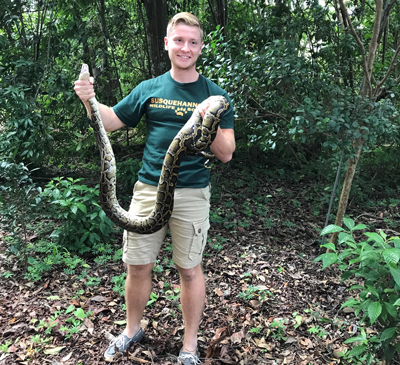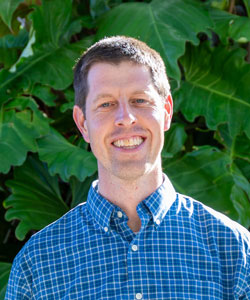By Kyra Gurney, University of Miami News
South Florida is crawling with invasive and non-native species.
Burmese pythons slither through the Everglades. Climbing ferns from as far away as Australia cover islands in protected wetlands. In urban areas, rainbow lizards from West Africa sunbathe on rocks while peacocks strut through front yards.
“South Florida has more non-natives than any other continental region in the world,” said Chris Searcy, an associate professor of biology at the University of Miami College of Arts and Sciences, referring to regions that are not islands. “When we do surveys in the urban parks in Miami, 93% of what we see is non-native reptiles and amphibians.”

While the percentage of non-native species in native habitats like the Everglades is lower, this is where they are doing the most damage. Burmese pythons have decimated the native rabbit population in the Everglades, for example, while Asian swamp eels, an invasive fish, are gobbling up native amphibians. The invasive species are imperiling a massive effort to restore the Everglades, which have already been damaged by human impacts.
This is why Searcy and his team in the Conservation Ecology Lab are trying to uncover patterns in the spread of non-native species. In particular, they are studying why some non-native species thrive in native habitats like the Everglades, while others are confined to urban areas. They are also investigating which of South Florida’s native habitats are most resistant to the invaders.
Searcy and his team have found that the best predictor of whether a non-native species is able to spread into South Florida’s native habitats is whether it is adapted to wetlands. They have also found that wetlands are the most resistant habitat to invasive species.
To reach these conclusions, Searcy and his team looked at millions of recorded sightings of non-native species. They created a database of traits for the most frequently observed species, including size, lifespan and the characteristics of their native habitat. The researchers then compared trait values between the non-native species most often found in native habitats and those that are mostly restricted to human-modified areas. They also referenced the species sightings against a map of all the native habitat patches across South Florida to identify which patches have the most sightings of non-native species compared to South Florida natives.
Their findings, which follow up on a review article they recently published in the Annual Review of Ecology, Evolution, and Systematics, have implications for how best to conserve the Everglades — a matter of debate among policymakers and scientists.
“To me, what this argues is that our best defense against the spread of the non-natives is to keep the wetlands wet,” Searcy said. “It’s just a subset of the non-natives that can tolerate that habitat, and it’s those wetland habitat types that are also most resistant to the majority of the invaders.”

The findings also suggest the need to better control the types of animals and plants imported into South Florida, Searcy added, as well as the importance of implementing stricter protocols for ensuring these species don’t escape from holding facilities. Many of the region’s invasive species were initially imported for sale as exotic pets or ornamental plants and escaped or were released.
“If the best predictor of penetrating native habitat is a wetland specialist, we should think very carefully about whether we want to be importing any wetland specialists, because if they get out, they’re likely to have a big impact,” Searcy said.
Searcy and his team are also researching the causes of a precipitous decline in amphibians in the Everglades — an estimated 80% drop between 1996 and 2019 — and whether invasive fish like the Asian swamp eel are partly to blame.
In 2025, Searcy’s lab plans to launch a study funded by the South Florida Water Management District to determine which non-native fish are the worst predators for amphibians. The lab will also look at whether the worst predators make up a greater portion of the non-native fish in the Everglades than they used to, which might help explain the decline in amphibians.
Conservation ecology research like the work Searcy and his team do can be grueling. Researchers spend hours in the sun as they conduct field work, wading into mud and crossing paths with potentially dangerous creatures like alligators.
But Searcy is committed to protecting natural ecosystems.
“It just seems like we have such an impact on all the other species on this planet that we have a moral obligation to try to do right by them,” he said.
This piece was originally published at https://news.miami.edu/as/stories/2024/12/tracking-invasive-species.html. Banner image: A brown anole lizard, one of the invasive species found in South Florida. (Photo: Hunter Howell).



